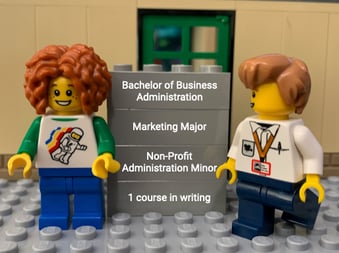Micro-credentials rising: a response to the EDUCAUSE Horizon Report
Higher Education must address a student’s ability to not just get a job, but to keep it. It’s more than interviewing well, it’s about having the requisite learning to perform on the job.
One of my favorite things as a kid was building with LEGO. With a few bricks, you can build anything you can imagine. The fun of construction does not have to stop there. You can combine your creation with other bricks to make something completely different. Your original design is still there, but now you have something more functional – maybe even more creative or meaningful.

The purpose of taking you with me down the construction toy aisle was to distill a particular vision for the future of higher education. The future of learning is micro, not macro. This perspective leverages stackable, measurable competencies to help graduates not just get a job but keep it.
EDUCAUSE Horizon Report & Micro-credentials
The 2022 EDUCAUSE Horizon Report for teaching and learning focused on some uncomfortable truths about the negative perception of earning a degree. The report notes that big tech companies no longer hire based on degrees, and the cost of attainment inflation further emphasizes skillset acquisition over persisting through four years of study (EDUCAUSE, 2022). Today’s learners crave an upskilling experience that gets them hired, while employers demand competency to ensure employment longevity. The current buzzword for a modularized approach to education is micro-credential.
The concept of micro-credentials pre-dates the 1803 ‘Lousiana Purchase’
Micro-credentials are not a new fad or a passing concept. The notion of educational building blocks began with Yale, predating the 1803 ‘Louisiana Purchase’ (Levine & Van Pelt, 2021). Micro-credentials represent a longstanding, unique process compared to traditional degrees, certificates, or sometimes grades in that they provide a more visible and granular view of academic attainment (Gish-Liberman, Twafik, & Gatewood, 2020). Micro-credentials offer learners a digital way to show their competency in a skill or mastery of a topic, often through evidential artifacts. There are two basic ways higher education could adopt the micro-credential concept: standalone or stacked (lattice) credentials.
Standalone micro-credentials are often described as ‘professional learning’ or ‘continuing education’. These micro-credentials are not necessarily just a course or a formal professional development opportunity but rather a recognition of the attainment of knowledge or acquisition of skills (Tooley & Prescott, 2021). Micro-credentials sometimes manifest in digital badges that can be shared on social and professional media platforms, formally recognized by the granting institution. Typically, these badges represent a one-off or less formal approach to skill development than a traditional degree plan.
A stacked or latticed credential method weaves micro-credentials into existing, traditional credentials like an associate’s or bachelor’s degree. Stacking offers colleges and universities the opportunity to formalize entry and exit points for students (Perea, 2020). These milestones provide students a layer of flexibility, allowing them to begin working while still pursuing additional credentials. Creating ‘stacked’ micro-credentials from existing, approved curriculum means institutions can speed up or circumvent some of the steps in the governance process because it has already been done. Using existing curricula in this way can offer institutions an opportunity for the rapid adoption of micro-credentials.
Rapidly deploy adoption of micro-credentials by stacking existing, approved credentials.
Micro-credentials & Employability
Regardless of the method or approach to micro-credentials in an institution, the process needs to consist of the alignment of learning outcomes to employability—an ultimate representation of student success. In 2020, Thomas Gauthier from Palm Beach State College wrote about his research on the value of micro-credentials from an employer’s perspective. While his study looked at employees in early childhood education, the results are universally applicable: employers need employees with authentic skills and the ability to use them to perform their roles competently (2020). Employers look at traditional degrees, and even with a transcript, they understand that occupying a seat in a class is not the same as demonstrable proficiency.
“Industry suggested that competency and experience were more valuable to the employer than a college degree.” – Thomas Gauthier, 2020.


When a graduate cannot provide evidence of proficiency, it generates a ripple effect. They find themselves under-earning compared to peers who can demonstrate competence. Lack of evidenced proficiency leads to salaries insufficient to pay for the debt accumulated to fund their education—which they believed would lead to a higher level of employment. However, institutions that support the assurance of learning when developing micro-credentials will not only give their students an advantage, they will make it easier for employers to recognize their value.
Micro-credential Management with CourseLoop
CourseLoop’s Micro-credential Management solutions enable institutions to rapidly propose, create, approve, and publish new micro-credential offerings that demonstrate skills and knowledge proficiency in a specific discipline, and even go beyond with advanced curriculum mapping for actionable insights.
- Dynamic workflow allocation takes the guesswork out of the approval process for fast and confident action.
- Collaborate with comments, tasks, and notifications to ensure everyone is kept abreast of the proposal process and that the right people contribute where and when they are needed.
- Flexible data model which allows you to capture critical data to promote stackability, portability, and curriculum assurance.
- Help students discover new pathways to success and promote lifelong learning.
- Automatically update information from a single source of truth, removing administrative burden while guaranteeing accurate information for students.
- Publish micro-credentials to your student catalog or shopfront. Or use our display layer to publish a modern, intuitive, and accessible catalog, with search-driven navigation and seamless integration with your branding.
- Visualize curriculum relationships and skills alignment and surface actionable insights to support continuous improvement with curriculum mapping.
Contact us to find out more about CourseLoop’s Micro-credential Management.
References
Gauthier, T. (2020). The value of microcredentials: The employer's perspective [Article]. Journal of Competency-Based Education, 5(2), 1-6. https://doi.org/10.1002/cbe2.1209
Gish-Lieberman, J. J., Tawfik, A., & Gatewood, J. (2021). Micro-Credentials and Badges in Education: a Historical Overview [Article]. TechTrends: Linking Research & Practice to Improve Learning, 65(1), 5-7. https://doi.org/10.1007/s11528-020-00567-4
Levine, A., & Van Pelt, S. J. (2021). The Great Upheaval: Higher Education's Past, Present, and Uncertain Future. JHU Press.
Pelletier, K., McCormack, M., Reeves, J., Robert, J., Arbino, N., Dickson-Deane, C., Guevara, C., Koster, L., Sanchez-Mendiola, M., & Bessette, L. S. (2022). 2022 EDUCAUSE Horizon Report Teaching and Learning Edition.
Perea, B. (2020). Using Smaller Credentials to Build Flexible Degree Completion and Career Pathways [Article]. New Directions for Community Colleges, 2020(189), 23-37. https://doi.org/10.1002/cc.20395
Tooley, M., & Prescott, S. (2021). Professional Learning in Appalachia. State Education Standard, 21(1), 18-24.
West, R. E., Tawfik, A. A., Gishbaugher, J. J., & Gatewood, J. (2020). Guardrails to Constructing Learning: the Potential of Open Microcredentials to Support Inquiry-Based Learning [Article]. TechTrends: Linking Research & Practice to Improve Learning, 64(6), 828-838. https://doi.org/10.1007/s11528-020-00531-2

